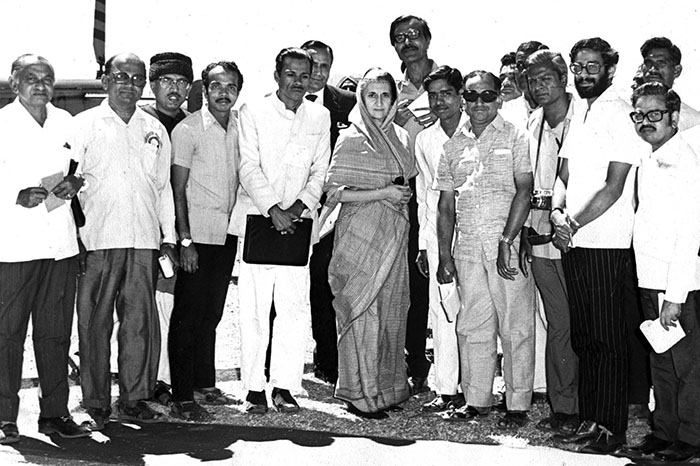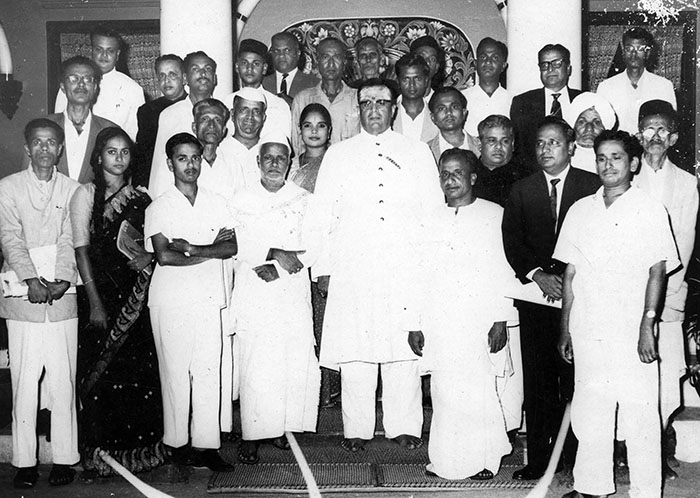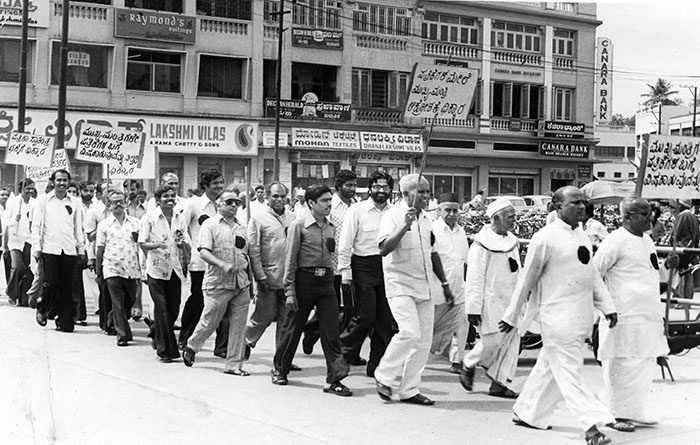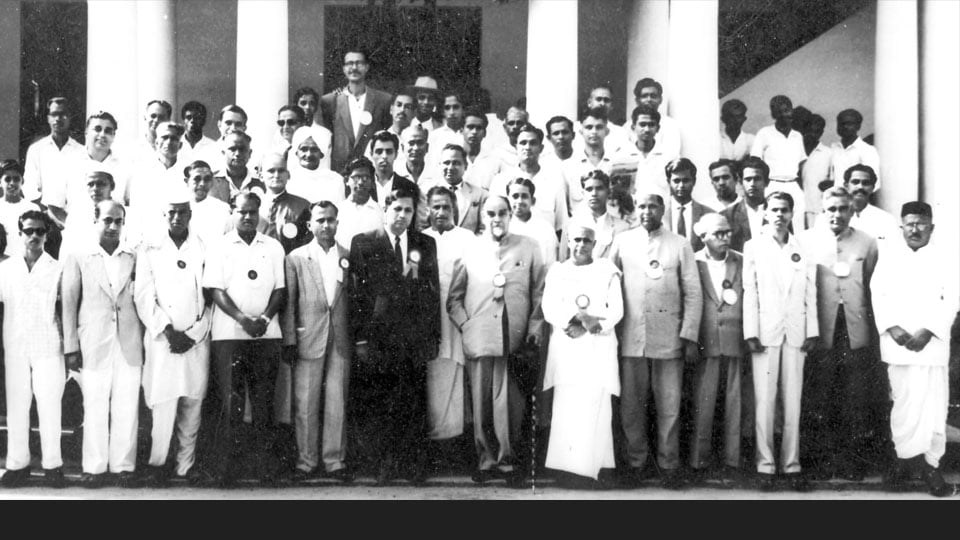By Gouri Satya, Sr.Journalist
On this day three years ago (Feb. 16, 2018), I wrote an article titled ‘Saga of Small Newspapers in Mysuru’ for the Anniversary Issue of Star of Mysore. For this Special Issue, I thought I should record some of the veterans with whom I was associated with during the early days of my career in journalism.
These men (there were no women journalists then) were role models for youngsters who entered the field newly. There were no schools or institutions which taught about journalism. To become a good journalist, one had to join a local newspaper, work under a senior journalist and gain knowledge and experience. He had to learn not only reporting but also proof-reading, editing, page layout etc.
The experience he gained and the ability to write good reports helped him to get a job in a bigger newspaper, either in Kannada or English. There was always scope for those who had good writing skill in any of these two languages or both. If he failed to achieve this, he had to give up his hopes of joining a newspaper. Thus, local newspapers served as a training ground for new entrants.
In the late 50s and 60s, Mysuru was a major centre of journalism. A large number of tabloids were being published from here. Perhaps there was no other city where such a large number of small newspapers were being brought out. At one time, they numbered nearly 40 and almost all of them were single-sheet Kannada dailies. Added to them, there were a few weeklies. The Editors of these dailies were prominent personalities, who had made a name. A few of them were politicians of standing in the city.
Besides the Editors of these small newspapers, there were reporters of State dailies and National dailies published from metropolitan cities like Bengaluru, Chennai (then Madras) or Mumbai (then Bombay).
Champion of cow protection
When I entered the field, one of the senior-most among the veterans was M.S. Krishna Rao, who published a Kannada tabloid called ‘Satyavadi.’ He was a freedom fighter and champion of cow protection. His cow protection call appeared daily in his newspaper, launched in 1917, in the form of an advertisement. Besides the cow protection campaign, it served another purpose — of lessening the task of filling the space there.
The situation in those days was not like today. Mysuru was a small city and more a pensioners’ paradise. Its population was around two lakhs. Public engagements and press meets were not many. The sources of news were very few. The Mysore Municipality was only the major source of news items. Consequently, dailies like ‘Sadhvi’ mainly covered religious activities like Harikathe, bhajan and approaching festivals in brief.
The Editor of ‘Sadhvi’, Agaram Rangiah, was a veteran freedom fighter. He had worked in the same publication published earlier as a Weekly in 1899 by its Founder-Editor M. Venkatakrishnaiah (Thathaiah), a pioneer of journalism in Mysuru.

Foreign newsprint from Mumbai
Under Agaram Rangiah’s stewardship from 1936, ‘Sadhvi’ rose to become a popular local Daily commanding a good circulation. There was a time when Rangiah was getting foreign newsprint from a Mumbai agency. Freedom fighters like Subba Rao Upadhyaya and H.V. Subbaramaiah assisted Agaram Rangiah in desk work. A bachelor, Subbaramaiah had also served ‘Pouravani’ and later a few other local dailies. ‘Pouravani’ was edited by veteran freedom fighter H.S. Doreswamy.
G.R. Josyer was another veteran who published a Weekly by the name ‘Rationalist.’ He was a student of Thathaiah. His columns drew the attention of top personalities, including those at the State-level. He was one of the pioneers of the Congress party in Mysuru and a member of the Representative Assembly and other institutions. He was also the Founder-President of the Mysore Journalists’ Association in 1937.
A scholar, he brought out books in Sanskrit and English. His publication, “Vymanika Sastra,” after tracing a manuscript in his house, drew attention from abroad also. He conducted the birthday celebration of Krishnaraja Wadiyar III every year without fail.
Quits clerk’s job for journalism
Another popular Kannada Daily was ‘Mysore Patrike,’ the Editor of which was T. Narayana. He quit a clerk’s job in the Law Court and chose journalism as a career in 1930. His strong Editorials attacking the Government and politicians compelled him to stop the publication for a brief period following an order by the Government.
His small office at Lansdowne Building was always crowded with one or the other leading journalists who visited it regularly. Famous novelist Ta.Ra. Subba Rao (Tarasu) and Kannada typewriter inventor Anantha Subba Rao worked for ‘Mysore Patrike’ besides others. Their stinging articles were most often the talk of the town. After T. Narayana, his son T. Venkataram took over the responsibility of its publication.
First Editor to subscribe to PTI news agency
Before joining ‘Mysore Patrike,’ Anantha Subba Rao had begun publication of a Kannada Daily, ‘Sevaka.’ He was the first Editor to subscribe to PTI (Press Trust of India) news agency. As there was no teleprinter in those days, the agency sent news items to him by telegram.
Another journalist who belonged to this genre was N. Sreenivasa Murthy, a dynamic reporter of the then popular Daily of Bengaluru, ‘Thayinadu.’ His long association with that paper since 1930 had made him popular as ‘Thayinadu’ Sreenivasa Murthy. Besides sending reports and photos, he wrote a regular column in ‘Thayinadu’ under the caption ‘Nagara Sanchari’ (city traveller). It was a popular column and attracted many readers across the State. He was often seen with a box camera at major events, particularly those associated with the Maharaja. The photo he sent to the paper was made into a lead or copper ‘block’ and then printed along with his report.
As a Senate member, he was associated with the Mysore University for over a quarter of a century. He was not afraid of lashing out at erring officials and politicians openly. Those who were closely associated with him called him ‘Bojja’ because of his belly.

Freedom fighter – scribes
After Independence, more local dailies appeared on the scene and there were more journalists. Among them was A. Ramanna, who launched the tabloid ‘Vijaya’ in 1947. Like his predecessors, he was also a freedom fighter and MLC. He was imprisoned during the ‘Emergency’ imposed by Prime Minister Indira Gandhi.
Another freedom fighter who started a Daily in 1947 was H.K. Kumaraswamy, a veteran co-operator. He began to publish ‘Aruna,’ a Kannada Daily. His strong Editorials had earned the wrath of the Government. Later, his brother K. Ramanna became its Editor.
Pioneer in tourism
Kannada Daily ‘Samachar,’ started by G.L. Swamy, became the first English Daily of the city when he converted it to that language. Swamy was a pioneer in tourism. He had established ‘The Tourist Bureau’ and published tourist literature and picture albums. Leading personalities, including top politicians and Ministers, were often visiting his office.
Almost all these personalities had carved out a place in the city, either in the social or political field apart from journalism. They wore simple Khaddar clothes like a dhoti and a jubba throughout their life. Agaram Rangiah could be seen always with a Gandhian cap, while Krishna Rao, T. Narayana and Anantha Subba Rao with a black cap and Josyer with the famous laced turban of Mysuru.
Gopalakrishna Rao was another senior reporter in Mysuru. He worked for ‘The Hindu’ published in Chennai (then Madras). A simple and unassuming person, he took down speeches delivered by VIPs at major functions in short-hand, sat before a type-writer and produced four or five copies of his report, and handed them over to his colleagues who included B.K. Gowda (Deccan Herald), Kalaiah (Prajavani) and N.V. Gundappa (Indian Express).
Before Gopalakrishna Rao, Krishnaswamy was the reporter of ‘The Hindu’ and also had shouldered the task of its distribution in the city. After Gopalakrishna Rao, R.S. Narayan became ‘The Hindu’ Correspondent. He earned a doctorate for his thesis on Mahatma Gandhi from the Mysore University. Subsequently, K. Srinivasan (who was popular as ‘Cheemu’) and his son, Bharath Kumar became the reporters of ‘The Hindu.’

‘Bomber’ Kalaiah
Kalaiah was a freedom fighter from Maddur and was famous as ‘Bomber’ Kalaiah. He courageously planted a bomb in a protest rally against the British when a curfew was in force. Like most of the freedom fighters, he was always seen with a Khadi dhoti and a jubba.
Gundappa was a ‘fire-brand’ reporter of the ‘Indian Express’ published from Chennai. He was not afraid of taking to task any official or politician, however big they may be, if they were indifferent towards Pressmen. He always stood by their side and safeguarded their interests. He would even walk-out of a Press Meet or refuse to attend it, if he found the Press was taken casually. A chain smoker, he too wore a dhoti and jubba. He remained a bachelor staying in a room in the Modern Hindu Hotel (now Hotel Hoysala of KSTDC). He met with a tragic death.
‘PTI’ Sastry
N.N. Sastry was another senior reporter. He began his career as a copywriter in the ‘Vrittanta Patrike’ published by the Wesley Press and became its Editor in 1930. He subsequently joined the ‘Madras Mail,’ an English Daily from Madras (Chennai). After working in a few other newspapers, he joined the PTI to become its first reporter and came to be identified as ‘PTI’ Sastry. He had also worked as a sports reporter of the ‘Deccan Herald.’ He was the first person to deliver a talk on Dasara Sports in the Akashvani, Mysuru.
Hard life after retirement
The pay these reporters were paid was meagre and they found it hard to see both ends meet. Besides working for the dailies they were representing, some of them worked in local newspaper offices, assisting its Editors, who were otherwise busy with other avocations. They got no monetary benefits after they retired and had to lead a hard life. Soft-spoken Gopalakrishna Rao worked in a grocery shop as a bill writer in Bengaluru after retirement. A few like ‘Thayinadu’ Srinivasa Murthy, N.V. Gundappa and H.V. Subbaramaiah remained bachelors.
Despite this, they led an honest life and served the newspapers they were representing loyally. They did not hesitate to write boldly against officials who failed to administer properly and even against the Maharaja’s administration if an occasion demanded. Even at times of hardship, they did not ask or borrow money from others but took up some part-time job to earn a few more rupees. They worked in the local dailies, as did H.L. Sreekanta Murthy, Gundappa, Subbaramaiah and N.N. Sastry, to add to their income.
A bold and outspoken journalist, H.L. Sreekanta Murthy, began his career as a reporter of ‘Hindustan Samachar’ in 1952. He later joined the ‘Varthaman’ of M.N. Thimmiah and also worked for ‘Thayinadu’ and subsequently ‘Samyukta Karnataka.’ As a reporter for AIR, he covered news items for its mofussil news bulletin and made it popular. Haa. La. as he called himself, was daring enough to ask embarrassing questions at Press Meets and put a speaker in an awkward place.
‘Varthaman’ was started by V.T. Raman, a theatre owner, in 1950 and M.N. Thimmiah took over it after some time. He became a Municipal Councillor and subsequently the Municipal President.
Another prominent politician of the city, P. Gopalakrishna Setty, published ‘Vishwavani’ Daily. After serving in some positions, he rose to become the Deputy Chairman of the State Legislative Council.
I am happy when I began my early career, I had the association of these veteran journalists, except Thathaiah. They spoke to juniors like me affectionately, guided us with their experience, and advise and shaped us to become good journalists. It is their guidance and advice which helped me step into the shoes of my father G.L. Swamy. Here I must remember the support and encouragement of Gundappa, in particular. He trained me thoroughly while he was working for ‘Samachar,’ assisting my father and me. I am sure a few other upcoming journalists also benefited from these elderly personalities.
Krishna Vattam came to Mysuru in 1959 as the Correspondent of the ‘Deccan Herald.’ Soon he became popular for his extensive coverage of news and articles. After retirement, he became the Editor of ‘Prajanudi’ published by the city’s leading politician, Vasu, an ex-MLA.
S. Pattabhi Raman, a champion of Gandhian ideals, worked for Deccan Herald’s sister Daily, ‘Prajavani.’ He was associated with organisations related to Gandhiji. He edited ‘Navadhwani’ Daily.
Among the reporters, H.K. Nagaraja Rao worked for the ‘Times of India’ of Mumbai (then Bombay). He sent brief reports of major events and occurrences. To support his income, he joined the Mangalore Ganesh Beedi Works as a stenographer-cum-typist.
Country’s first Sanskrit Daily
Pandit K.N. Varadaraja Iyengar tread a new path. A Sanskrit scholar, he launched the country’s first Sanskrit Daily, ‘Sudharma’ in 1970 and earned encomiums from all over. He was chiefly responsible for the introduction of Sanskrit news bulletins in the All India Radio.
Others who joined the profession during this and the subsequent period included, to name a few, B.P.R. Vittal (Rajya Dharma – 1967), Brahmadevaiah and his son B.S. Ravindranath (Ashoka), H.C. Basavanna (Mahanandi – 1985), H.N. Narasimha Murthy (Independent – 1962), Narayana Raju followed by his son, M.N. Anantha Raju (Vishwadhoota -1977), D. Jayadevaraje Urs followed by Chandrasekhara Kukkikatte (Sankranthi – 1977), Malali Nataraj (Mysore Digantha – 1977) and K.V. Sreenivasan (AIR). Sreenivasan, a champion of Gandhian ideals, is known among the juniors as ‘Brother.’
The write-up would be incomplete if I fail to highlight the contribution of K.B. Ganapathy (KBG) and Rajashekar Koti, who added a new dimension to the local journalism. Ganapathy launched the popular English Daily ‘Star of Mysore’ in 1978 and a sister Daily in Kannada, ‘Mysuru Mithra’ (1980). Koti began ‘Andolana’ in Kannada in 1977 as a Weekly and later switched it to a morning Daily.
With bigger size, more pages and extensive coverage of both Mysuru and the surrounding towns, and adopting modern technology, they opened up a new front in the field of journalism in the city. They established spacious offices and employed personnel required for editing and publishing the Daily. While actively guiding them, they saw to the growth of their dailies, both in circulation and earnings. The contribution of Ganapathy is significant for he has been continuing to publish two dailies, one in English (Star of Mysore) and the other in Kannada (Mysuru Mithra).
A few others like D. Jayadevaraje Urs (Sankranthi – 1977), H.C. Basavanna (Mahanandi – 1985), Malali Nataraj (Mysore Digantha – 1997) and Dr. Ajay Kumar (Prajanudi – launched in 2000 and later taken over by ex-MLA Vasu), made similar efforts but, except one or two newspapers, the rest folded up after a short period of existence.








Recent Comments